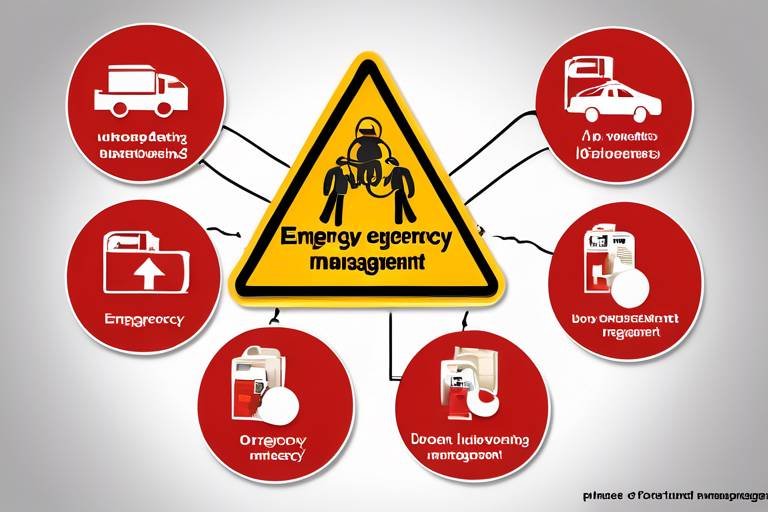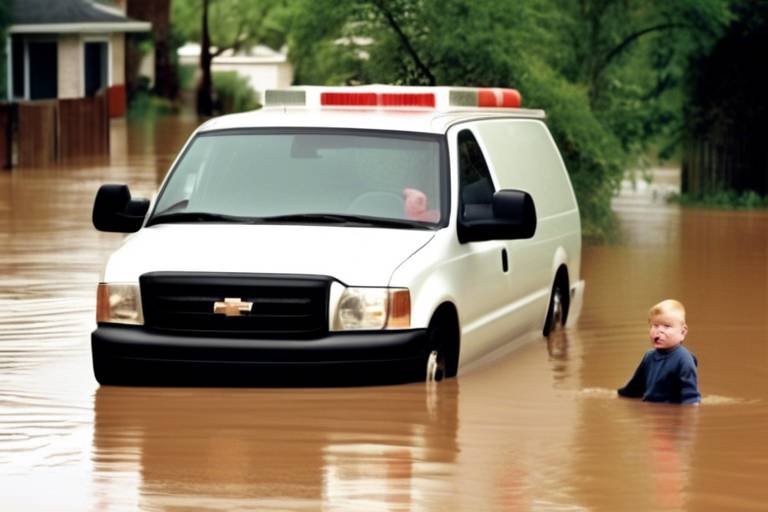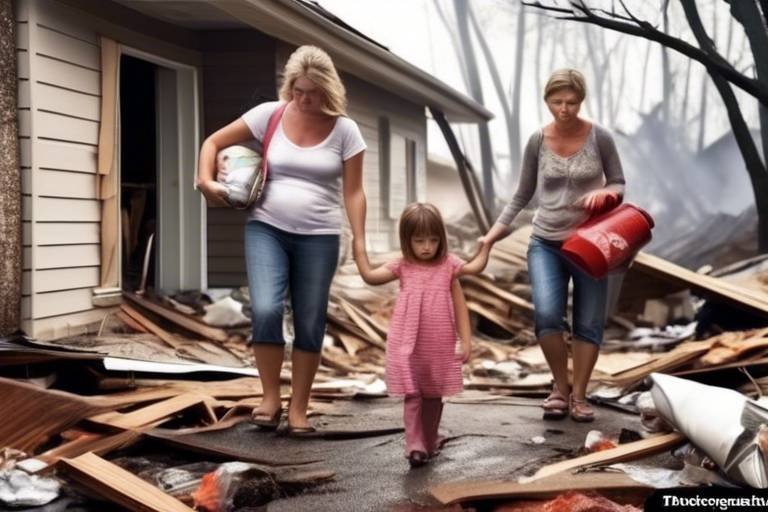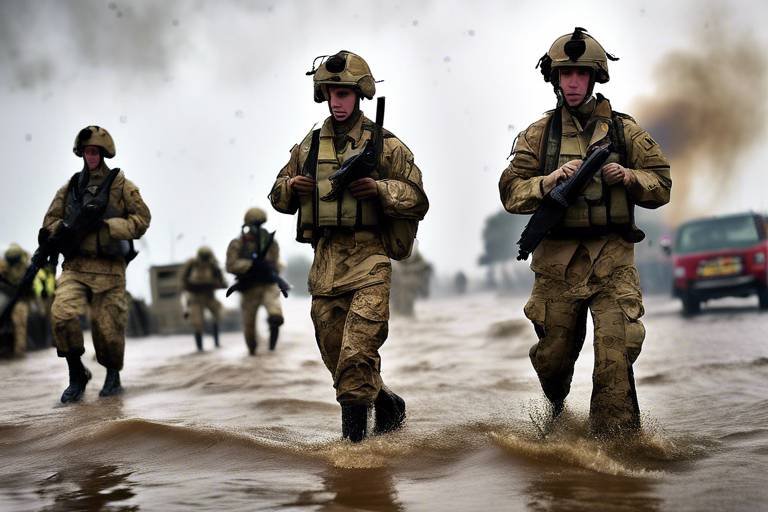The Impact of Disasters on Mental Health
Disasters, whether natural or man-made, can have a profound impact on the mental health of individuals and communities. Imagine waking up one day to find your home destroyed by a flood or a wildfire, or witnessing the chaos of a terrorist attack. The immediate physical destruction is often accompanied by a wave of emotional turmoil that can linger long after the dust has settled. The psychological effects of such traumatic events can manifest in various ways, leading to conditions like anxiety, depression, and post-traumatic stress disorder (PTSD).
Understanding these psychological consequences is crucial for developing effective mental health interventions. It's not just about physical recovery; the emotional scars can be just as debilitating. For many, the aftermath of a disaster can feel like navigating through a thick fog where clarity seems impossible. The uncertainty and fear can lead to a sense of helplessness, making it essential for survivors to have access to support systems that can guide them through their healing journey.
Furthermore, the impact of disasters extends beyond the immediate victims. Families, friends, and entire communities can feel the ripple effects of trauma. The shared experience of a disaster can either bring people together or create rifts, depending on how the situation is handled. This is why addressing mental health in the wake of disasters is not just an individual concern; it’s a community imperative. By fostering a culture of support and understanding, we can help ensure that those affected do not suffer in silence.
In the following sections, we will delve deeper into the psychological effects of disasters, explore coping strategies that survivors often employ, and examine the critical role of community support in recovery. We will also highlight the importance of early intervention and effective response plans that prioritize mental health considerations. By shining a light on these aspects, we aim to provide a comprehensive understanding of how disasters impact mental health and what can be done to mitigate those effects.
Disasters can lead to various psychological issues, including anxiety, depression, and PTSD. Understanding these effects is crucial for developing effective mental health interventions for affected individuals.
Survivors often employ various coping strategies to deal with trauma. This section will discuss effective methods that can help individuals navigate their emotional responses post-disaster.
Community support plays a vital role in recovery. This subheading will explore how social networks and community initiatives can help individuals heal and rebuild after a disaster.
Peer support groups provide a safe space for sharing experiences. This section will delve into the benefits of these groups in fostering resilience among disaster survivors.
Access to professional counseling can significantly aid recovery. This part will discuss the importance of mental health professionals in addressing trauma and promoting healing.
Resilience varies among individuals. This section will examine the personal traits and circumstances that contribute to an individual's ability to cope with disaster-related stress.
Early intervention can mitigate long-term mental health issues. This subheading will highlight the significance of timely support and resources for disaster-affected individuals.
Creating robust response plans is essential for minimizing mental health impacts. This section will outline strategies for disaster preparedness that prioritize mental health considerations.
First responders often face significant stress. This part will discuss the importance of mental health training for first responders to improve their resilience and support for affected communities.
Q: What are the common psychological effects of disasters?
A: Common psychological effects include anxiety, depression, PTSD, and feelings of helplessness and fear.
Q: How can individuals cope with the aftermath of a disaster?
A: Individuals can cope by seeking support from friends and family, joining peer support groups, and accessing professional counseling services.
Q: Why is community support important in recovery?
A: Community support fosters a sense of belonging and understanding, which can significantly aid emotional healing and resilience among survivors.
Q: What is the role of early intervention?
A: Early intervention can prevent the development of long-term mental health issues by providing timely support and resources to those affected by disasters.

The Psychological Effects of Disasters
Disasters, whether natural or man-made, can significantly disrupt lives, leaving deep scars that often go unnoticed. The psychological effects of such events are profound and far-reaching, impacting not just the immediate victims but also their families and communities. Imagine waking up one day to find that everything you knew and loved has been shattered—this is the reality for many survivors. The emotional fallout can manifest in various ways, including anxiety, depression, and post-traumatic stress disorder (PTSD).
Understanding these psychological effects is crucial for developing effective mental health interventions. For instance, research shows that individuals exposed to disasters are at a higher risk of developing anxiety disorders. This can lead to a persistent state of worry, where the mind constantly replays traumatic events, making it difficult to focus on daily tasks. Moreover, the feelings of helplessness and vulnerability can spiral into depression, where survivors may feel a profound sense of loss and hopelessness.
PTSD is another significant concern. Survivors may experience flashbacks, nightmares, and severe emotional distress when reminded of the traumatic event. These symptoms can be debilitating, affecting one's ability to work, maintain relationships, and engage in everyday activities. It's like being trapped in a never-ending loop of fear and anxiety, where the past continuously intrudes upon the present.
To illustrate the impact of these psychological effects, consider the following table that summarizes common mental health issues faced by disaster survivors:
| Mental Health Issue | Symptoms |
|---|---|
| Anxiety Disorders | Excessive worry, restlessness, fatigue, difficulty concentrating |
| Depression | Persistent sadness, loss of interest in activities, changes in appetite, feelings of worthlessness |
| PTSD | Flashbacks, nightmares, severe emotional distress, avoidance of reminders |
Furthermore, the psychological impact of disasters can extend beyond individual experiences. Families may struggle to cope with the shared trauma, leading to strained relationships and increased conflict. Children, in particular, can be affected in unique ways, as they may not fully understand what has happened or may feel abandoned if caregivers are overwhelmed by their own distress. This generational trauma can create a cycle of mental health issues that persists long after the disaster has passed.
In conclusion, the psychological effects of disasters are complex and multifaceted. They require a comprehensive approach to address the needs of survivors effectively. Recognizing the signs of mental health issues is the first step in providing the necessary support. By fostering an environment where individuals feel safe to express their feelings and seek help, we can begin to heal the invisible wounds left by these catastrophic events.
- What are the most common psychological effects of disasters? The most common effects include anxiety disorders, depression, and PTSD.
- How can survivors cope with the psychological aftermath of a disaster? Survivors can benefit from various coping strategies, including seeking support from friends and family, joining support groups, and accessing professional counseling services.
- Why is community support important for disaster survivors? Community support fosters resilience, helps individuals feel less isolated, and provides essential resources for recovery.

Coping Strategies for Survivors
When disaster strikes, the emotional aftermath can feel like a heavy fog that lingers long after the storm has passed. Survivors often find themselves grappling with a whirlwind of feelings—fear, confusion, and even guilt. It’s essential to recognize that coping with these emotions is not just about surviving the immediate aftermath; it’s about thriving in the long run. So, how do individuals navigate this turbulent emotional landscape? There are several effective coping strategies that can empower survivors to reclaim their lives.
One of the first steps in coping is acknowledging the feelings that arise after a disaster. Many people may feel tempted to shove their emotions aside, thinking it will make them stronger. However, recognizing and validating your feelings is crucial. It’s okay to feel overwhelmed; it’s okay to cry. In fact, allowing oneself to express emotions can often lead to a healthier recovery process. Journaling can be a powerful tool in this regard, providing a private space to articulate feelings and thoughts. It’s like having a conversation with yourself, helping to clarify what you’re experiencing.
Another strategy is to establish a routine. After a disaster, life can feel chaotic and unpredictable. Re-establishing a sense of normalcy can be incredibly comforting. This can include setting regular meal times, engaging in daily activities, or even following a structured schedule. By creating a routine, survivors can regain a sense of control over their lives, which is often lost in the turmoil of a disaster.
Moreover, connecting with others is vital. Humans are inherently social creatures, and having a support network can make a world of difference. Whether it’s reaching out to friends, family, or joining a support group, sharing experiences can foster a sense of belonging and understanding. Peer support groups, in particular, provide a safe haven where survivors can share their stories and learn from one another. It’s like a warm blanket on a cold night—comforting and reassuring.
In addition to community support, engaging in physical activity can also be a fantastic coping mechanism. Exercise releases endorphins, which are natural mood lifters. Whether it’s going for a walk, practicing yoga, or dancing to your favorite tunes, moving your body can help alleviate stress and improve mental health. It’s a simple yet effective way to boost your mood and regain a sense of agency.
Lastly, seeking professional help is a crucial component of recovery. Mental health professionals can provide invaluable tools and strategies tailored to individual needs. They can help survivors process their trauma and develop coping mechanisms that work best for them. Remember, asking for help is not a sign of weakness; it’s a courageous step toward healing.
In summary, coping with the aftermath of a disaster is a deeply personal journey, and there’s no one-size-fits-all approach. By acknowledging feelings, establishing routines, connecting with others, engaging in physical activity, and seeking professional help, survivors can navigate their emotional responses and work towards healing. It’s about finding what resonates with you and taking those small yet significant steps forward.
- What are some common emotional responses after a disaster? Survivors may experience anxiety, depression, anger, or even guilt. It's important to recognize these feelings as normal reactions to trauma.
- How can I find a support group? You can check with local mental health organizations, community centers, or online platforms that connect individuals with similar experiences.
- Is it necessary to seek professional help? While not everyone may need professional help, it can be beneficial for those struggling to cope. A mental health professional can provide tailored support and coping strategies.

The Role of Community Support
When disaster strikes, whether it's a natural calamity like a hurricane or an unexpected man-made event such as an industrial accident, the ripple effects can be devastating. However, amidst the chaos, one of the most powerful forces for recovery is community support. Imagine a sturdy bridge that connects individuals to resources, emotional backing, and a sense of belonging. This bridge is built on the foundation of community, fostering resilience and healing in the wake of tragedy.
Community support manifests in various forms, from informal networks of friends and family to organized relief efforts by local organizations. These connections are incredibly vital for survivors, as they help individuals feel less isolated and more understood. When people come together to share their experiences, it creates a shared narrative that can be profoundly healing. For instance, a neighborhood that rallies together to provide meals, shelter, or emotional support creates a safety net that can significantly alleviate feelings of anxiety and despair.
Moreover, community initiatives often provide practical assistance that can ease the burdens of recovery. This can include:
- Resource Distribution: Local organizations can help distribute food, clothing, and essential supplies to those affected.
- Emotional Support: Community members can offer a listening ear, which is often just as important as physical aid.
- Rebuilding Efforts: Volunteers can assist in the physical rebuilding of homes and infrastructure, which fosters a sense of accomplishment and hope.
One of the most profound aspects of community support is the creation of peer support groups. These groups provide a safe space for individuals to share their stories and emotions, helping to normalize the varied responses to trauma. When survivors hear others articulate their struggles, it can validate their feelings and reduce the stigma often associated with mental health issues. In these groups, individuals learn that they are not alone in their experiences, which can be incredibly empowering.
Furthermore, community support can also take the form of organized mental health initiatives. Local governments and non-profits often collaborate to provide workshops and training sessions aimed at equipping community members with the skills to support one another. These programs can teach basic counseling skills, stress management techniques, and ways to recognize signs of trauma in others. By investing in community education, we create a more resilient society capable of responding to crises with compassion and understanding.
In summary, the role of community support in the aftermath of disasters cannot be overstated. It serves as a crucial lifeline that connects individuals to the resources they need to heal. By fostering a sense of belonging, providing practical assistance, and facilitating emotional connections, communities can significantly enhance the recovery process for disaster survivors. The strength of a community lies in its ability to come together during challenging times, proving that even in the darkest moments, hope and healing are possible through collective support.

Peer support groups serve as a beacon of hope and healing for those navigating the tumultuous waters of post-disaster trauma. Imagine standing on the edge of a stormy sea, feeling lost and overwhelmed, but then finding a group of people who have weathered similar storms. This is the essence of peer support groups—creating a safe harbor where individuals can share their experiences, emotions, and coping strategies. These groups foster a sense of belonging and understanding, which is often crucial for recovery. When survivors come together, they not only validate each other's feelings but also cultivate a collective resilience that can be incredibly powerful.
One of the most significant benefits of peer support groups is the opportunity to connect with others who truly understand what you’re going through. It's like finding a tribe that speaks your language, where the shared experiences can lead to profound conversations and insights. Members often find solace in knowing they are not alone in their struggles, which can significantly reduce feelings of isolation and despair. In these groups, individuals can express their fears, share their stories, and discuss their coping mechanisms, all while receiving encouragement from those who have faced similar challenges.
Additionally, peer support groups can help survivors develop practical coping strategies. For instance, participants might share techniques that have worked for them, such as mindfulness practices, journaling, or engaging in creative outlets like art and music. This exchange of ideas can empower individuals to try new approaches to manage their emotions and reactions in the aftermath of a disaster. Moreover, the informal nature of these groups often makes them more accessible than traditional therapy, allowing individuals to seek support without the stigma that sometimes accompanies mental health treatment.
To illustrate the impact of peer support groups, consider the following table that outlines some key benefits:
| Benefit | Description |
|---|---|
| Shared Understanding | Members relate to each other's experiences, fostering empathy and connection. |
| Emotional Validation | Participants feel acknowledged and understood, reducing feelings of isolation. |
| Practical Coping Strategies | Members share effective techniques for managing trauma-related stress. |
| Increased Resilience | Collective support can enhance individual and group resilience. |
In conclusion, peer support groups play a vital role in the recovery process for disaster survivors. They create a nurturing environment where individuals can heal together, learn from one another, and build lasting connections. Whether it’s through sharing stories, offering encouragement, or simply being present for one another, these groups embody the strength found in community and the power of shared experiences. For many, joining a peer support group can be the first step toward reclaiming their lives after a disaster, providing not just support, but also a renewed sense of hope and purpose.

When disaster strikes, the emotional aftermath can be overwhelming. This is where professional counseling services come into play, acting as a beacon of hope for those navigating the turbulent waters of trauma. These services are not merely a luxury; they are a crucial lifeline for individuals grappling with the psychological scars left by natural or man-made disasters. Imagine trying to swim through a stormy sea without a life raft—professional counselors are that life raft, offering support, guidance, and strategies to help survivors regain their footing.
Professional counselors are trained to recognize and treat a wide range of mental health issues that may arise after a disaster. From anxiety and depression to post-traumatic stress disorder (PTSD), their expertise enables them to tailor interventions to meet the unique needs of each individual. This personalized approach is essential because, just like no two disasters are the same, neither are the psychological responses to them. Counselors often employ various therapeutic techniques, such as cognitive-behavioral therapy (CBT), mindfulness practices, and trauma-focused therapies, to help individuals process their experiences and develop healthier coping mechanisms.
Moreover, the role of professional counselors extends beyond individual therapy sessions. They often collaborate with community organizations and support groups to create a comprehensive network of care. This collaboration can include organizing workshops, support groups, and educational seminars that empower survivors with the tools they need to heal. For instance, counselors might facilitate group therapy sessions where individuals can share their stories and learn from one another, fostering a sense of community and collective healing.
It's also important to highlight that access to professional counseling can vary significantly based on location, resources, and individual circumstances. In many cases, survivors may face barriers such as financial constraints or lack of availability of mental health services. To address these challenges, some communities have initiated programs that provide free or low-cost counseling services to disaster survivors. These initiatives are crucial in ensuring that everyone has the opportunity to seek help and begin their journey toward recovery.
In summary, professional counseling services play an indispensable role in the recovery process following a disaster. They offer not only immediate support but also long-term strategies for coping with trauma. By fostering resilience and providing a safe space for individuals to express their feelings, counselors help survivors navigate their emotional landscape and ultimately rebuild their lives. In a world where disasters can strike at any moment, having access to these services is not just beneficial—it's essential.
- What types of mental health issues can counseling address after a disaster?
Counseling can help with a range of issues, including anxiety, depression, PTSD, and grief. - How can I find professional counseling services in my area?
You can search online for local mental health resources, contact community health centers, or ask for referrals from healthcare providers. - Are there free counseling services available for disaster survivors?
Yes, many communities offer free or low-cost counseling services specifically for disaster survivors. Check local organizations for available resources. - How long does counseling typically last?
The duration of counseling varies based on individual needs and circumstances, but many find significant relief within a few sessions.

When we talk about resilience in the face of disasters, it's like discussing the secret ingredients in a recipe that make a dish truly special. Just as some foods blend together to create a delightful flavor, certain individual traits and circumstances can combine to foster resilience in disaster survivors. So, what exactly are these resilience factors? Well, let’s dig a little deeper!
First and foremost, personal traits play a significant role in how individuals respond to trauma. Characteristics such as optimism, adaptability, and emotional regulation can act as protective factors. For instance, someone who maintains a positive outlook is more likely to find silver linings even in the darkest of times. It's like having a mental flashlight that helps them navigate through the shadows of despair.
Moreover, social connections are another crucial component of resilience. Strong relationships with family, friends, and community can provide a safety net during turbulent times. Think of it as a sturdy parachute that helps cushion the fall when life takes a nosedive. Individuals who have robust support systems often report feeling less isolated and more empowered to face their challenges. In fact, research shows that having a reliable support network can significantly reduce feelings of anxiety and depression after a disaster.
Additionally, previous experiences with adversity can shape how one copes with future challenges. Those who have faced and overcome difficulties may develop a sense of confidence and competence, believing that they can handle whatever comes their way. It’s akin to a warrior who, after surviving battles, becomes more skilled and resilient in the face of new threats. This accumulated wisdom can be a powerful tool in navigating the emotional aftermath of a disaster.
Furthermore, access to resources, such as mental health services and educational opportunities, can significantly bolster resilience. When individuals have the tools and knowledge to cope with stress, they are better equipped to manage their emotional responses. For example, learning coping strategies through therapy or community workshops can empower survivors to take control of their healing journey. It’s like giving them a toolbox filled with essential tools for rebuilding their emotional well-being.
In summary, individual resilience is not a one-size-fits-all concept. It’s a complex interplay of personal traits, social support, past experiences, and available resources. Understanding these factors can help us better support those who have faced the unimaginable, enabling them to bounce back stronger and more capable than before. After all, just like a well-crafted piece of art, resilience is about blending various elements to create something beautiful out of chaos.
- What are individual resilience factors? Individual resilience factors include personal traits, social connections, previous experiences with adversity, and access to resources that help individuals cope with stress and trauma.
- How can social connections improve resilience? Strong social connections provide emotional support, reduce feelings of isolation, and enhance a person's ability to cope with challenges, acting as a buffer during tough times.
- Can past experiences influence resilience? Yes, previous experiences with adversity can build confidence and competence, making individuals more resilient in facing future challenges.
- What role do mental health services play in resilience? Access to mental health services equips individuals with coping strategies and tools necessary for managing emotional responses, significantly aiding their recovery.

When disaster strikes, whether it's a natural calamity like a hurricane or a man-made event such as a terrorist attack, the aftermath can be overwhelming. One critical aspect that is often overlooked in the chaos of recovery is the significance of early intervention for mental health. The sooner support is provided, the better the chances are for individuals to avoid long-term psychological issues. Think of it like catching a cold; if you treat it early, you can often prevent it from turning into something more severe, like pneumonia.
Research indicates that individuals who receive timely mental health support after a disaster are less likely to develop chronic conditions such as Post-Traumatic Stress Disorder (PTSD), anxiety, and depression. Early intervention can take many forms, including immediate psychological first aid, community support initiatives, and professional counseling services. These interventions act as a safety net, providing the necessary tools and resources to help individuals process their experiences and emotions.
To illustrate the impact of early intervention, consider the following table, which outlines the differences in outcomes for those who received early support versus those who did not:
| Intervention Type | With Early Support | Without Early Support |
|---|---|---|
| PTSD Development | 15% risk | 40% risk |
| Chronic Anxiety | 10% risk | 30% risk |
| Depression | 12% risk | 35% risk |
This stark contrast highlights just how crucial early intervention can be. But what does early intervention look like in practice? It can involve a variety of strategies, including:
- Psychological First Aid: Providing immediate support and resources to help individuals cope with their feelings and reactions.
- Community Outreach: Initiatives that bring people together to share their experiences, fostering a sense of belonging and mutual support.
- Access to Professional Help: Ensuring that mental health professionals are available to assist those in need, guiding them through their recovery journey.
Moreover, early intervention is not just beneficial for the individuals affected by the disaster; it also has a ripple effect on the community as a whole. When people receive the help they need, they are more likely to contribute positively to their communities, rebuilding and strengthening social ties that may have been fractured during the crisis. Imagine a garden; if you water the plants early, they grow strong and vibrant, creating a beautiful landscape. In the same way, early intervention nurtures the emotional well-being of individuals, which in turn fosters a healthier community.
In conclusion, the importance of early intervention in the wake of disasters cannot be overstated. It serves as a crucial lifeline for those grappling with the psychological aftermath, preventing long-term mental health issues and promoting recovery. By prioritizing early mental health support, we can help individuals not only survive but thrive after a disaster.
- What is early intervention? Early intervention refers to the prompt provision of mental health support and resources following a traumatic event.
- Why is early intervention important? It significantly reduces the risk of developing chronic mental health issues and promotes quicker recovery.
- What types of support are available? Support can include psychological first aid, community outreach programs, and access to professional counseling services.

When it comes to disasters, whether natural or man-made, having a well-structured response plan can be the difference between chaos and recovery. Think of it as a roadmap that guides individuals and communities through the turbulent waters of crisis. An effective response plan not only addresses immediate safety concerns but also lays the groundwork for long-term mental health support. After all, the emotional scars left by disasters can linger long after the physical damage has been repaired.
First and foremost, it's essential to involve community members in the planning process. This ensures that the response plans are tailored to the specific needs of the population. Engaging local leaders, mental health professionals, and residents can foster a sense of ownership and responsibility. When people feel that their voices are heard, they are more likely to participate actively in recovery efforts.
Moreover, a comprehensive response plan should include mental health considerations. This might involve:
- Establishing communication channels for mental health resources
- Training community members to recognize signs of distress
- Creating safe spaces for individuals to share their experiences and feelings
In addition, it's crucial to conduct regular drills and training sessions. Just as fire drills prepare us for emergencies, mental health drills can equip communities with the tools they need to respond to emotional crises. These drills can simulate various disaster scenarios, allowing participants to practice identifying and addressing mental health needs in real-time. By doing so, communities can build a resilient network that is prepared to support each other when disaster strikes.
Lastly, evaluating and updating response plans regularly is vital. The landscape of mental health and disaster response is ever-evolving, and what worked in the past may not be effective in the future. Gathering feedback from community members and mental health professionals can provide insights into what needs to be improved. This iterative process ensures that response plans remain relevant and effective, ultimately leading to better outcomes for those affected by disasters.
In conclusion, developing effective response plans is not just about immediate action; it's about creating a sustainable framework for recovery. By prioritizing mental health, engaging the community, and continually refining strategies, we can pave the way for healing and resilience in the aftermath of disasters.
Q: What is the primary purpose of a disaster response plan?
A: The primary purpose is to ensure the safety of individuals and provide a structured approach to recovery, including mental health support.
Q: How can community members get involved in developing response plans?
A: Community members can participate by attending planning meetings, providing feedback on proposed strategies, and volunteering for training sessions.
Q: Why is mental health a critical component of disaster response?
A: Mental health is crucial because disasters can lead to long-lasting psychological effects, and addressing these needs is essential for overall recovery.
Q: How often should disaster response plans be updated?
A: Plans should be reviewed and updated regularly, ideally at least once a year or after any significant disaster event.

When disaster strikes, first responders are often the first line of defense, rushing into chaotic situations to provide aid and support. However, the nature of their work can be incredibly taxing, both physically and emotionally. It's essential to recognize that training for first responders goes beyond mere technical skills; it encompasses mental health training as well. This dual approach not only equips them to handle emergencies effectively but also prepares them to cope with the psychological toll that such high-stress environments can impose.
First responders face unique challenges that can lead to significant stress and trauma. For instance, witnessing traumatic events, dealing with loss, and making life-and-death decisions can weigh heavily on their mental well-being. To combat these challenges, training programs must include components that focus on resilience and mental health awareness. This training can help responders develop skills to manage stress, recognize signs of burnout, and seek help when needed.
Moreover, effective training programs should incorporate the following key elements:
- Stress Management Techniques: First responders should be taught various stress management techniques, such as mindfulness, breathing exercises, and physical fitness routines. These practices can help them maintain their mental health in the face of overwhelming situations.
- Trauma-Informed Care: Understanding the effects of trauma on both themselves and the individuals they assist is crucial. Training should provide insights into trauma-informed care, allowing responders to approach situations with empathy and awareness.
- Peer Support Systems: Establishing peer support networks can create a culture of openness where first responders feel safe discussing their experiences and emotions. Training should encourage the formation of these networks to foster resilience.
In addition to these elements, ongoing education is vital. The landscape of emergencies is ever-evolving, and so are the psychological challenges that accompany them. Regular workshops, refresher courses, and mental health resources can keep first responders informed and prepared. By investing in their mental health training, organizations ensure that their teams are not just effective in the field but also resilient in the face of adversity.
Ultimately, the goal of training for first responders should be to create a balanced approach that prioritizes both technical skills and mental health. When responders are equipped to handle their own emotional well-being, they are better positioned to provide the care and support that communities desperately need in times of crisis. This holistic training approach not only enhances their performance but also contributes to a healthier, more resilient workforce.
Q: Why is mental health training important for first responders?
A: Mental health training is crucial for first responders as it equips them with the skills to manage stress and trauma, ensuring they can perform effectively while also taking care of their emotional well-being.
Q: What types of stress management techniques are taught in training?
A: Training often includes techniques such as mindfulness, deep breathing exercises, physical fitness routines, and coping strategies to help manage stress in high-pressure situations.
Q: How can peer support systems benefit first responders?
A: Peer support systems create a safe space for first responders to share their experiences and challenges, fostering a sense of community and helping to reduce feelings of isolation.
Q: Is ongoing education necessary for first responders?
A: Yes, ongoing education is essential as it keeps first responders updated on the latest techniques and knowledge, ensuring they are prepared to handle the evolving nature of emergencies and their psychological impacts.
Frequently Asked Questions
- How do disasters impact mental health?
Disasters can lead to a range of mental health issues, including anxiety, depression, and post-traumatic stress disorder (PTSD). The chaos and trauma associated with such events can disrupt daily life and create long-lasting psychological effects. It's essential to recognize these impacts early on to provide appropriate support and interventions.
- What coping strategies can help survivors?
Survivors often turn to various coping strategies to manage their emotional responses. These may include talking about their experiences, engaging in physical activities, practicing mindfulness, or seeking professional help. It's important for individuals to find what works best for them, as everyone copes differently.
- Why is community support important after a disaster?
Community support plays a crucial role in recovery by providing a sense of belonging and shared experience. Social networks can offer emotional backing, practical assistance, and resources that help individuals rebuild their lives. The collective strength of a community can significantly enhance resilience among its members.
- What are peer support groups?
Peer support groups are safe spaces where individuals who have experienced similar traumas can come together to share their stories and feelings. These groups foster resilience by allowing participants to connect, learn from each other, and feel less isolated in their experiences.
- How can professional counseling help?
Access to professional counseling is vital for those affected by disasters. Mental health professionals can provide tailored support, helping individuals process their trauma and develop coping strategies. Counseling can also facilitate healing by addressing underlying issues that may arise post-disaster.
- What factors contribute to individual resilience?
Resilience can vary widely among individuals due to personal traits, past experiences, and social support systems. Factors such as optimism, adaptability, and a strong support network can enhance one's ability to cope with the stress and trauma associated with disasters.
- Why is early intervention crucial?
Early intervention is essential in mitigating long-term mental health issues following a disaster. Providing timely support and resources can help individuals process their experiences and reduce the risk of developing chronic conditions like PTSD or severe anxiety.
- What should be included in effective response plans?
Effective response plans should prioritize mental health considerations alongside physical safety. This includes training for first responders on mental health awareness, establishing support networks, and ensuring access to mental health resources in the aftermath of a disaster.
- How can first responders manage their stress?
First responders often face significant stress due to their roles in disaster situations. Mental health training can equip them with tools to manage their own stress and provide better support to those affected. It's crucial for these professionals to prioritize their mental well-being to effectively assist others.



















